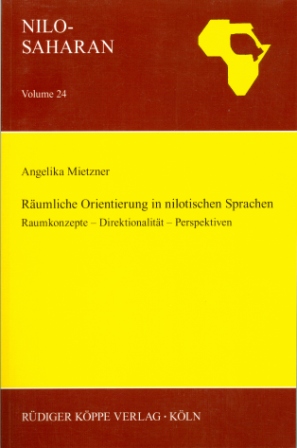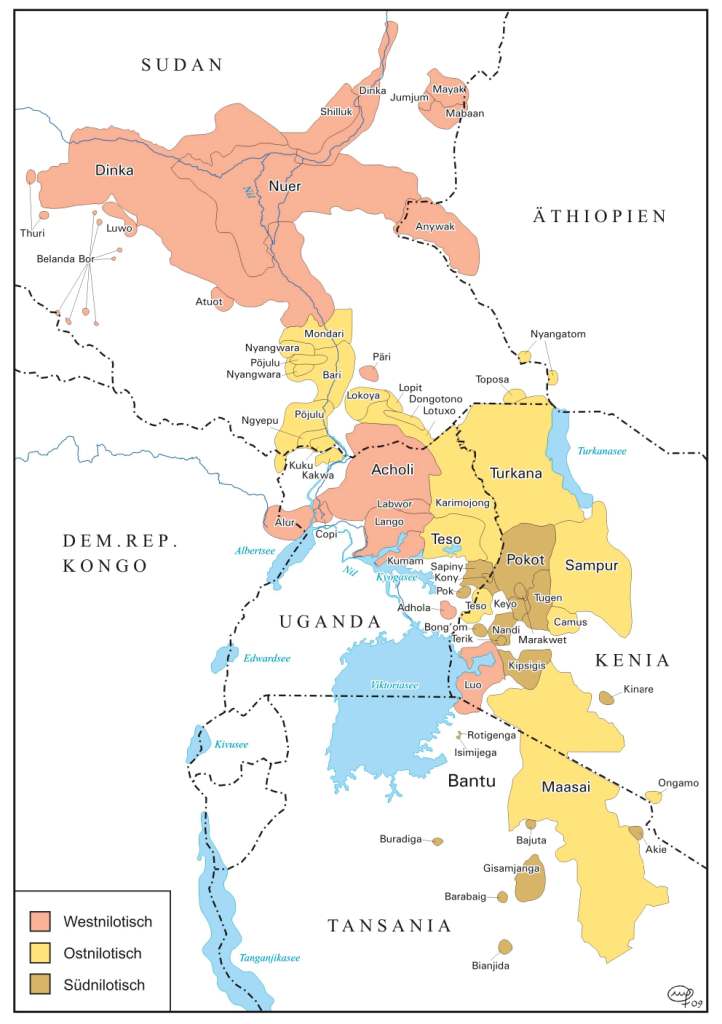

Räumliche Orientierung in nilotischen Sprachen
Raumkonzepte – Direktionalität – Perspektiven / with an obituary for Marvin Lionel Bender (1934–2008) by Franz Rottland
Author: Angelika Mietzner. With contributions by: Franz Rottland †. Series edited by: Anne Storch, Norbert Cyffer, Franz Rottland †, M. Lionel Bender †.
Series: NISA Nilo-Saharan – Studies in Language and Context Volume 24
2009239 pp.
9 colour maps, 11 colour pictures, numerous b/w pictures, numerous tables and charts
Text language(s): German
Format: 160 x 240 mm
430 g
Paperback
€ 49.80
Buy 'Räumliche Orientierung in nilotischen Sprachen' as a downloadable PDF document directly from our online shop »
Order 'Räumliche Orientierung in nilotischen Sprachen' as print edition »
The Nilotic languages appear in a range from Sudan in the North to Tanzania in the South and from Uganda in the West to Kenya in the East. Some of these languages are also spoken in the West of Ethiopia. This comparative study analyzes domains of spatial orientation, directionality and the perspective on their changeability concerning semantic functions. In this way, for example terms for directions in the various Nilotic languages cannot be traced back to one particular Proto-nilotic form, they rather show distinct lexemes which are dependent on the type of landscape or other characteristics defining the residential area of the speakers.
A similar diversity can be seen in form of the verbal morphemes of direction itive and ventive which do not appear exclusively as directional morphemes but implicate semantic functions such as simultaneity or temporal distance as well. These cannot be connected to direction anymore. The verbalization of perspective views, usually described by means of the single-file model and the face-to-face model, is as well a domain of spatial orientation unstable in language contact situations.
Out of these – and further – observations emerges a divergency in the domains of spatial orientation. Hence there is no availability of descriptions concerning spatiality and perception for Nilotic languages at hand, the present study also contributes to the descriptive situation of the usage of spatiality and perception in particular Nilotic languages.
Under these links you will find further studies of encoding / conceptualization of space, motion and emotion in African languages:
Accompanying material:
- Anthropologie des Raumes
(ISBN 978-3-89645-217-7 ) - Cherang’any
(ISBN 978-3-89645-666-3 ) - Cherangany–English and English–Cherangany Dictionary
(ISBN 978-3-89645-224-5 ) - Comparing African Spaces
(ISBN 978-3-89645-013-5 ) - Deictics, Copula, and Focus in the Ethiopian Convergence Area
(ISBN 978-3-89645-293-1 ) - Directionality in Grammar and Discourse
(ISBN 978-3-89645-899-5 ) - Encoding Emotions in Swahili
(ISBN 978-3-89645-715-8 ) - Encoding Motion – Case Studies from Africa
(ISBN 978-3-89645-505-5 ) - Konzeptualisierung von Landschaft
im Mbukushu (K.333/K.43) Bantusprache in Nord-Namibia)
(ISBN 978-3-89645-600-7 )
Cross-reference:
- A Dictionary of the Nandi Language
(ISBN 978-3-89645-134-7 ) - Nilo-Saharan – Models and Descriptions
(ISBN 978-3-89645-665-6 ) - Perception of the Invisible
(ISBN 978-3-89645-603-8 )
Reviews
Die Arbeit von Angelika Mietzner bietet nicht nur einen ausgezeichneten Beitrag zur kognitiven Semantik in den Nilotischen Sprachen, sie gibt auch einen gründlichen und sehr ausführlichen Einblick in Sprachdaten des Ost-, West- und Südnilotischen in den Bereichen Himmelsrichtung, Deixis und der Grammatikalisierung von Direktionalität (Itiv und Ventiv). Das Buch ist sowohl für den theoretisch als auch für den mehr deskriptiv orientierten Wissenschaftler interessant und lesenswert. [...]
Die vorliegende Arbeit stellt einen Durchbruch in zweierlei Hinsicht dar. Sie konzentriert sich erstens auf die Semantik der nilotischen Sprachen und schließt so eine Lücke neben den gut dokumentierten Arbeiten in Syntax, Phonologie und Morphologie. Des Weiteren kann die Autorin nachweisen, dass die Grundkonzepte Trajektor und Landmarke, Grundkonzepte der Kognitiven Grammatik von Langacker (1987), sich zur Analyse kognitiver Perspektiven in Sprachen gut eignen, wodurch sie einen theoretischen Beitrag zum Bereich der kognitiven Semantik bietet.
[Vollständiger Text / complete review:]
https://www.afrikanistik-aegyptologie-online.de/archiv/2011/3028/
Helga Schröder in Afrikanistik-Ägyptologie online, www.afrikanistik-aegyptologie-online.de/archiv/2011, 23-28
| « back | Print version | [top] |
 Books
Books Audio
Audio Biographies
Biographies Series
Series Festschrifts
Festschrifts Journals
Journals